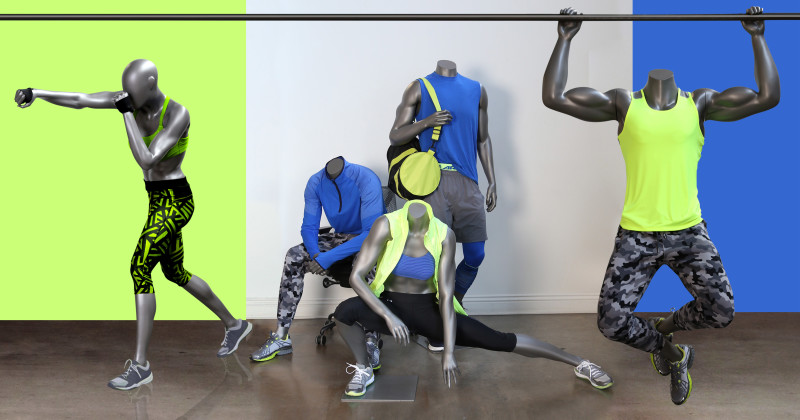Run specialty retailers have just seconds of a potential customer’s attention to pull them into their store Ñ and they only have one chance to make a good first impression. It is vital to get it right, especially when it comes to the apparel selection and presentation.
With that in mind, retailers have to realize that the first point of impact is their windows. As the calling card of their business, the impression they leave will either attract enough interest to make a customer come in, or walk past without a second glance.
Are your windows setting you up for success in selling your running apparel? Do they create excitement or missed opportunities?
As the pandemic winds down and customers begin enthusiastically returning to brick-and-mortar, it is especially important to let your windows speak for your store’s apparel focus. The question is: How do you effectively do this?
In Clear Focus
An effective window display should focus on a clear presentation and representation of the apparel being sold. The merchandising message should be specific and color coordinated Ñ too much clutter and mix of product can be confusing and turn the customer away.
The use of mannequins to display merchandise is the single most effective way to display product. Mannequins breathe life into otherwise lifeless pieces of clothing and add attitude and excitement to the overall image of the store.
In short, mannequins are your biggest allies when it comes to making that first impression Ñ not only because they create a large visual presence, but because they are the perfect Silent Salesperson, continually selling product without interaction. And they never take coffee breaks!
Customers relate to them on a personal level as well. Mannequins are inspirational to look at, their sculpted aspirational bodies encourage and allow the customer to see themselves in the merchandise displayed.
Another issue to consider: There is now much focus on inclusiveness and body positivity for society as a whole. This has become reflective in the athletic and running markets as well, where there has been a big push to promote and include larger sizes, particularly in women’s categories, which also includes mannequin representation.
Mannequins should represent the customer and the brand identity and be reflective of the apparel being sold. Too often athletic brand retailers use female fashion mannequins, their lithe, sinewy bodies perched on their toes obviously meant to wear high heels. While these mannequins look great at Saks, they certainly do not represent the athletic lifestyle run specialty retailers are promoting and selling.
Another frequent mistake is the use of inferior mannequins. While they may be less expensive, they do not offer value. A mannequin with bad proportions will cheapen the presentation and create damage to the identity and reputation of a brand.
Don’t Overshadow the Goods
Here are a number of other factors to consider in your mannequin presentation:
¥ The right mannequins will be effective in selling products without overshadowing the merchandise. Select bodies and poses that are a true reflection of your customer, product diversity and brand.
¥ The selection of sport-specific and lifestyle mannequin availability is varied and wide; however, the use of basic mannequins is effective as well, as long as the bodies represent the lifestyle and brand.
¥ Elevate mannequins on platforms to further create visual impact and excitement.
¥ Mannequin color is equally important. Bright colors and glossy finishes tend to pull focus from the merchandise; these are more effectively used for fashion brands. Color should be subtle and complementary to the store interior, while allowing the specific body, pose and merchandise create authenticity.
¥ Merchandising plays a key role in the effectiveness and success of displays. If a customer loves what’s on the mannequin, but struggles to find the merchandise, it is likely they will become frustrated with the experience and think twice about a purchase or revisiting a store. Merchandise apparel displayed on a mannequin near the presentation, so customers can find the desired items with ease.
¥ It is very important that as merchandise sells mannequin outfits are changed often to feature new products and encourage new sales.
Signage or Mannequins
In lieu of mannequins, some stores focus on graphics and signage. While they are both effective in combination with mannequins and or mannequin forms, they alone cannot create the kind of visual impact, excitement and response needed to maximize apparel sales.
For a smaller retailer even a single mannequin or two can make a huge difference. If budget is an issue, there are mannequin forms that speak to specific categories that are economical to purchase.
Using forms within the store helps to identify a specific department or category. Forms that display T-shirts, leggings, underwear and/or hosiery can be effective visual markers and lead-ins to other departments, while also creating desirable visual impact.
Savvy retailers understand that utilizing mannequins and forms are the most effective visual tools for increased sales. Mannequins should be seen as an investment in a retailer’s ultimate success and bottom line.
Finally, a story from my experience: I can remember as a traveling stylist returning to a store to change out the mannequins and a sales associate commented, “I hate when you change the mannequins in our windows. They look great, but everything sells out!”
The point lost on that associate was that this was the sole intent of visual display and the power of mannequins Ñ I took it as a compliment.
About the author
David Naranjo is VP–creative for Greneker, a mannequin manufacturer founded in 1934. His experience with the world of visual display and mannequins started in 1984 as a visual assistant and stylist for Charlotte Russe, a women’s clothing chain. Over his decade as stylist, area manager and visual director at Charlotte Russe, he discovered the power and impact of visual merchandising, mannequins and window displays.






